High Cable Curl Master Class
Get wider, thicker arms by targeting the short head of the biceps with this unique cable curl exercise.

Get wider, thicker arms by targeting the short head of the biceps with this unique cable curl exercise.

Note: The above video was recorded as a Facebook Live tutorial in conjunction with the Train With Jim Full-Body Shortcut to Size program.
The high cable curl is a somewhat novel biceps exercise, but it’s not a new one. Bodybuilders, physique athletes, and serious gym rats have been using this move for many years to build bigger, more muscular arms.
In fact, the high cable curl directly mimics the famous front-double-biceps pose in bodybuilding, so that may have something to do with why people tend to like this exercise so much.
The biceps brachii muscle is comprised of two heads: the long (outer) head and the short (inner) head. The two heads work together, but you can place more focus on one head or the other by changing your arm position.
When you do the front-double-biceps pose and you make that peak, it’s mainly the long head providing that. However, just because you're flexing the arm with the high cable curl in the same position as the front-double-biceps pose doesn't mean that the exercise is going to maximize your peak .
To target the long head to maximize the biceps peak, you want to internally rotate the arms (turn the arms inward); that’s why the hammer curl is a good exercise for the peak, because the neutral grip (palms facing in) internally rotates the arms. Also, bringing the arms behind the body to stretch the long head during the curl will emphasize it.
Now, look at the high cable curl (photo below). What am I doing here, with my arm up? Well, first of all, I don't have internal rotation; if anything, I have external rotation of the arm. And since that’s the opposite of internal rotation, which focuses on the long head, what is external rotation going to hit? The short head!
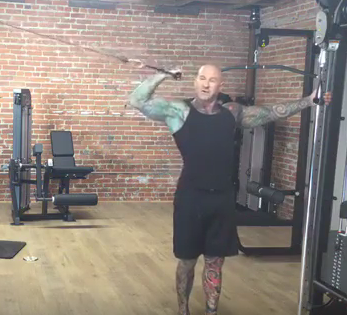
Also, in this high cable curl position, I don't have any stretch on the long head, so that’s another clue that the exercise hits more of the short head.
Hitting the short head is important because that's what gives width and thickness to your biceps. When you look at your arms in that front-double-biceps position, you can really see how wide and thick your biceps are (or aren’t!). That’s coming mainly from the short head. So don't always focus on just the long head to build the peak. The short head is just as important for overall development and aesthetics.
Before I get into all the nitty-gritty specifics of the exercise, here’s a brief description of how to do the standard two-arm high cable curl:
One thing that needs to be discussed with this exercise is equipment. High cable curls are to be done at a cable crossover station, but there’s a difference between a true cable crossover machine and what we call a dual cable station.
The latter might look like a cable crossover, but a dual cable station is actually narrower than a cable crossover apparatus. Problem with this is, you’re not able to get a full range of motion (ROM) and a full stretch at the bottom of the movement when doing the two-arm version of the high cable curl.
If you think about it, let’s say your wingspan is 6 feet wide (if you’re around 6 feet tall). At the start of the motion on a two-arm high cable curl, you’re standing in the middle of the cable station and your arms are fully extended out to your sides, so you’re using that full wingspan. Also, factor in that the stirrup handle attachments add even more width. And, of course, you need to keep constant tension on the muscles throughout the exercise, so the weights should never rest on the stack between reps. What I’m saying is, if your cable station isn’t good and wide, you won’t be able to effectively do a two-arm high cable curl.
The reason I’m getting into this is because the cable crossover station at my training facility – The JYM in Hollywood – is, in fact, a true cable crossover, but it’s still not wide enough to allow me to achieve a full ROM with a two-arm high cable. My arms are fairly long, plus the stirrup handles I use are long as well.
As you can see here, my arms aren’t quite at full extension:
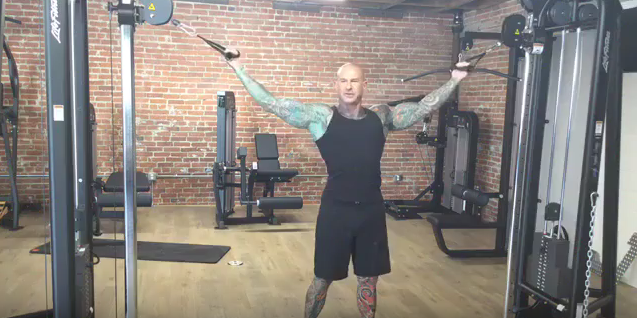
One little trick you can use to do two-arm high cable curls when the machine’s not quite wide enough is to kneel down so you can get a bit more stretch. It's a little awkward this way because the line of pull isn't quite as horizontal; it's more vertical, coming down. But you can give that a try if you want.
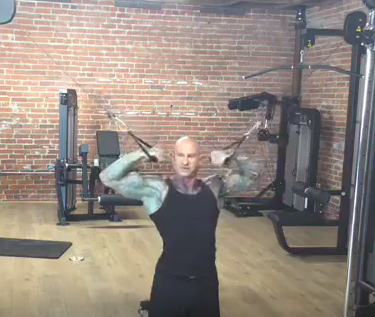
Point being, in the photos below (as well as in the above video), I’m focusing on the one-arm version of the high cable curl – mainly because of my equipment limitations (cable crossover station not wide enough at The JYM). But the basic technique is still the same, so it doesn’t change the overall purpose of the exercise at all. If the crossover station at your gym is plenty wide, go ahead and do the two-arm version. If it’s not, stick to the one-arm high cable curl to make sure you achieve a full ROM.
With this particular exercise, you want more of a horizontal line of pull, and that's why with the single-arm version is better than the kneeling version, and arguably better than the standing two-arm version as well.
As we step away from the other pulley (as is the case with the one-arm version), we get more horizontal resistance.
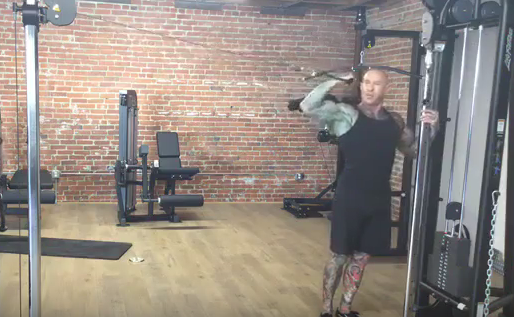
The closer I am, the more vertical (up and down) the resistance is going to be. Same as if I lowered the pulleys to the ground; the closer I get, the more vertical the line of pull is.
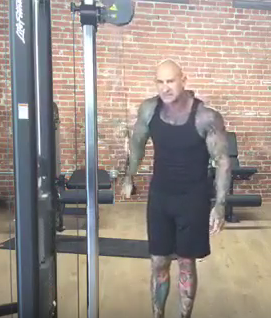
Another reason I like the one-arm version is that you’re going to be stronger on single-arm exercises. That doesn't mean you can lift more with one arm than you can lift with two; it just means that the weight you can curl with two arms is going to be less than double what you’d be able to curl with one arm.
If that’s not making sense to you, here’s an example. Let’s say you can curl 100 pounds with two arms. If that’s the case, you’ll be able to do more than 50 pounds (half the two-arm weight) for the same number of reps when doing the one-arm version.
So let’s say you can do a 60-pound curl with one arm, but only a 100-pound curl two arms, which would be a pretty typical differential. A 100-pound two-arm curl means that each arm is curling 50 pounds, which is 10 pounds less than with the one-arm version (again, assuming the same number of reps are performed). You're stronger when you're able to focus on one limb because you’re maximizing “neurological drive” – your neurons are firing to those motor units and muscle fibers, allowing you to be stronger . You're also able to put all of your focus on that one arm, which leads to a better mind-muscle connection with the biceps.
As I said before, I’ll be focusing on the one-arm version of the high cable curl here.
Because I'm training one arm at a time, I'm going to go across to the other side of the cable crossover station to hold on, just to stabilize myself. I'm pulling myself all the way across so that at the end of the range of motion, I still have resistance.
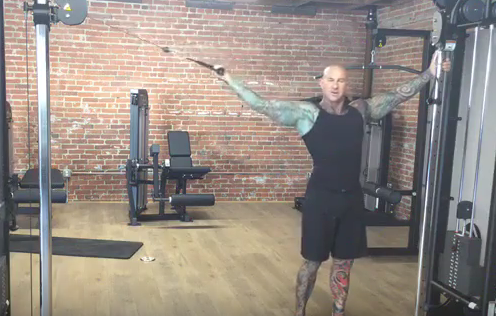
From the start position, all I’m doing is keeping the upper arm stationary and just flexing the biceps. Curl it in as far as you can to get a good peak contraction at the end.
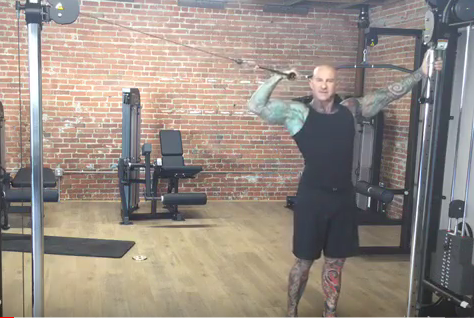
Then, slowly return on the negative, allowing the arm to go all the way straight. That’s one rep. Do all reps with that arm, then switch sides and do the same thing.
I’ve covered two variations above (two-arm and one-arm high cable curls), but below are some other versions you can do that involve the same movement and emphasis.
If you train at home and don't have cables, you can do this exercise with bands. Simply tether the bands to a high point on a stable structure. You can do these one at a time very easily; or, if you have the proper setup, you can set two bands on either side and do the two-arm version.
If you don't have cables or bands, you can also use free weights. What you're going to do here is lie on a flat bench on your side, holding a dumbbell in one hand, and mimic the movement so that the working arm is perpendicular to your body. You’ll turn 90 degrees so that the arm is hanging down toward the floor and then curl upward.
Remember, if you don't have the equipment I'm showing here, get creative and find a solution. Look at the movement and the body position. You're doing a curl here with cables at a high setting, so it's not going to be the same as just taking a dumbbell and doing regular standing curls. A standard dumbbell curl is perfectly fine if that's your only option – meaning, you don’t have cables or bands or a bench to mimic the movement with a dumbbell.
But remember, variety rules, in all areas: rep ranges, rest periods, rep speeds, and so on. In this case, we’re talking about variety in exercise selection. The high cable curl will provide great variety in an arm-training routine normally dominated by barbell and dumbbell curls.
Again, this is a great exercise particularly for hitting that short head to build thickness in the biceps. I talk a lot about training the long head to build more of a biceps peak, but that inner (short) head is also important to focus on as well. You want to be maximizing the development of both heads for better overall biceps development and overall arm size. Try bicep ladders to help add more size.
Find this exercise on Day 4 (arms focus workout) of all four weeks of my Full-Body Shortcut to Size program.
Related Articles